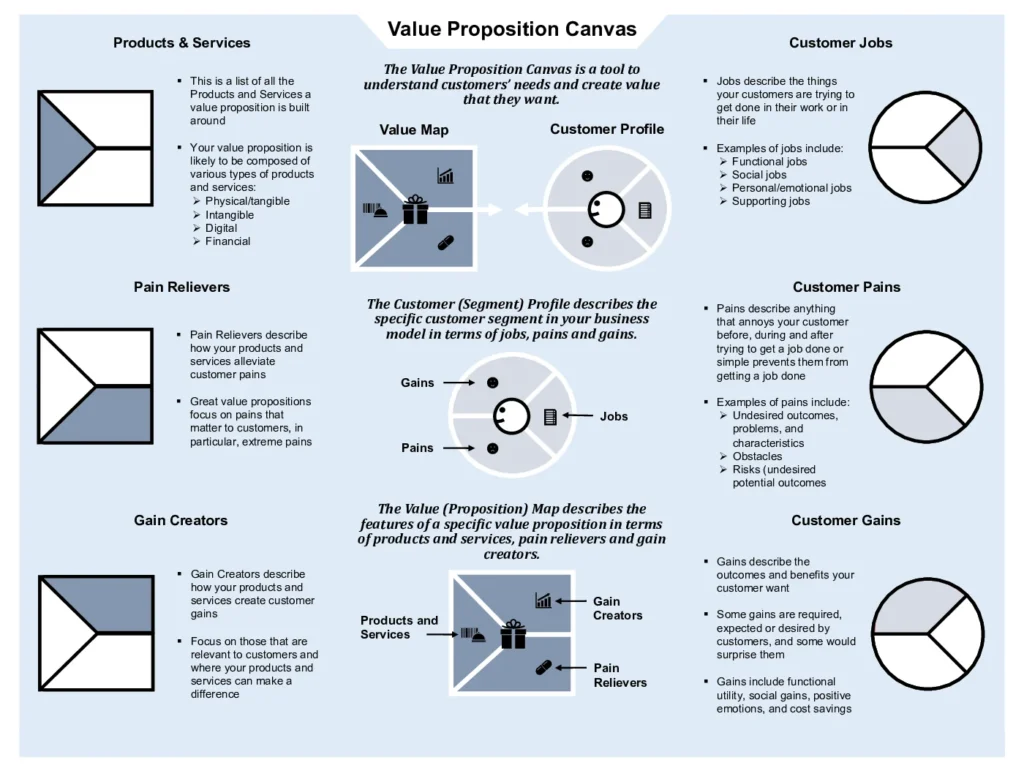
Designing Value That Customers Recognise Instantly
Most failures are not bad ideas. They are bad fits.
When an offer does not solve a real customer problem, the outcome is predictable. Resources are wasted, teams feel frustrated, and the market does not respond. If you want a business model that holds up, it must be customer driven. That requires seeing the customer’s world clearly. What they are trying to achieve, what slows them down, and what would genuinely delight them. The Value Proposition Canvas is a precise way to do this work.
Why the Value Proposition Canvas Exists
The purpose is fit.
The Value Proposition Canvas (VPC) is a visual framework that makes your value proposition visible, testable, and actionable. It sits alongside the Business Model Canvas (BMC). The BMC outlines your whole model. The VPC zooms in on two blocks. Customer Segments, which define who you serve. Value Proposition, which defines what you offer. The aim is alignment between the two so that your offer maps directly to what matters most for a chosen segment.
The Cost of Guessing
Guesswork is expensive.
As described in Value Proposition Design, common patterns appear when teams try to create offers without a shared process. People work hard on the wrong priorities, it is difficult to learn what customers really want, meetings lack alignment, and ambitious projects fail in execution. The VPC replaces guessing with a disciplined, shared method that aligns language, focus, and decisions.
What the Canvas Makes Possible
It clarifies reality and reduces risk.
- Visualise customer realities. See patterns in jobs, pains, and gains so value creation becomes deliberate.
- Align teams. Give everyone the same frame and process for faster, better decisions.
- Reduce risk. Test and refine assumptions before committing full resources.
Used consistently, the VPC becomes part of your leadership worldview. It grounds decisions in the lived experience of the people you serve.
The Two Halves of the Canvas
Fit both sides and you earn traction.
The canvas has two sides. The Customer Profile on the right. The Value Map on the left. Your goal is a precise fit between them, in ways a customer recognises instantly.
1. Customer Profile
Work with one segment at a time.
Define a clear buyer persona rather than a vague demographic. Map their jobs, gains, and pains with specificity.
1.a Jobs to Be Done
These are the tasks customers are trying to complete, the problems they want solved, or the needs they seek to satisfy. Jobs may be functional, social, or emotional.
- Functional. Book a flight, install a bookshelf, manage a budget.
- Social. Signal status, belong to a group, earn respect.
- Emotional. Feel secure, calm, inspired, or confident.
Example. A small business owner wants to file accurate tax returns, be seen as a competent leader, and feel in control of cash flow.
1.b Gains
These are the benefits the customer wants, from essentials to delightful surprises.
- Required. Without this, the solution fails. Coloured pencils must colour.
- Expected. Standard features customers assume. A comfortable grip.
- Desired. Non essential, yet valued. A built in sharpener.
- Unexpected. Positive surprises. Recycled materials and plant based dyes.
1.c Pains
These are obstacles, risks, or negative emotions the customer experiences while doing the job.
- Functional. Software crashes and work is lost.
- Social. Delivering late looks unprofessional.
- Emotional. The process feels stressful and confusing.
Prioritisation
Not every item matters equally.
Rate each job, gain, and pain by impact and frequency. Start with items that are both high impact and frequent. Consider emotional intensity and cost to the customer as secondary tiebreakers.
2. Value Map
Describe your offer in response to the profile.
2.a Products and Services
List what you provide, whether tangible, intangible, digital, or financial. Example. An accounting software subscription, guided onboarding, and ongoing customer support.
2.b Pain Relievers
Explain how your offer reduces the customer’s pains. Example. Automated data backup removes the risk of losing information, while guided workflows prevent common errors.
2.c Gain Creators
Show how your offer creates the gains that matter most. Example. Real time dashboards increase confidence and control, and alerts anticipate issues before they become costly.
Prioritisation
Sharp beats broad.
Focus on the most relevant pains and gains. Remove features that do not map to a high priority customer need. This creates clarity for the team and resonance for the customer.
Creating the Fit
Fit is a direct match.
A strong fit exists when your products and services relieve the most important pains and create the most important gains for a specific segment. If any feature on your value map does not match a top pain or gain, remove it. This prevents bloat and keeps the proposition compelling.
Example of Fit
Make it concrete and observable.
1 Customer Profile. A parent wants effective cleaning, to protect children’s health, and to be seen as environmentally responsible. Key pains include harsh chemicals, poor results, and high costs.
2 Value Map. Plant based, non toxic cleaners, refillable packaging, and competitive pricing, with independent safety certifications.
Result. The customer recognises that health concerns are addressed, environmental values are honoured, and the budget holds. This is fit in action.
Your Next Step
Start small and go deep.
- Select one customer segment you already serve.
- Map their jobs, gains, and pains with real quotes and observations.
- Map your products, pain relievers, and gain creators.
- Cut anything that does not answer a top pain or gain.
- Test one assumption with a quick customer conversation or prototype.
The strength of your business is not in how much you offer. It is in how precisely your offer meets what matters most to your customer.
References
Value Proposition Design. Alexander Osterwalder, Yves Pigneur, Greg Bernarda, and Alan Smith. Wiley, 2014.